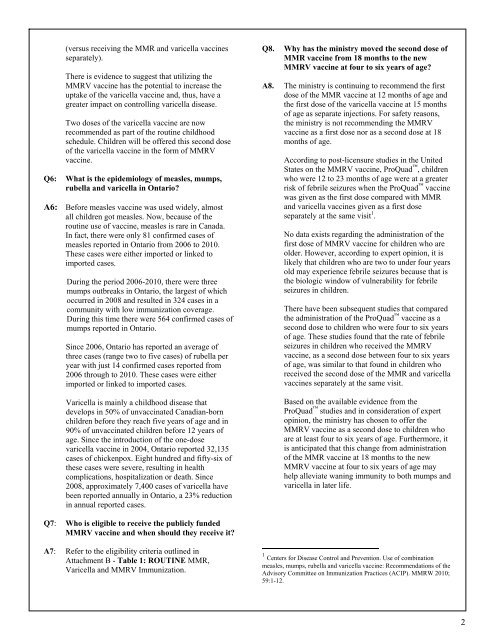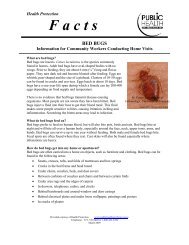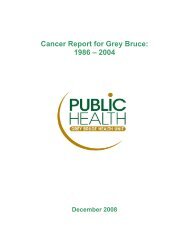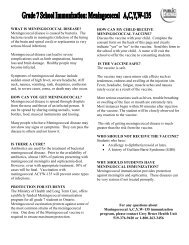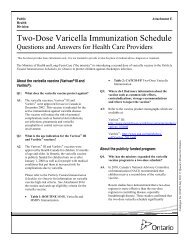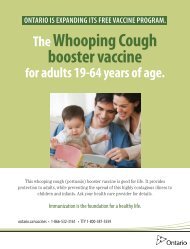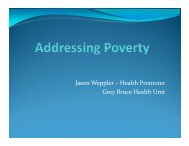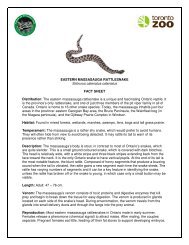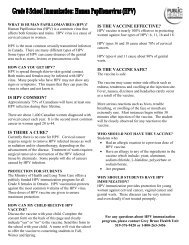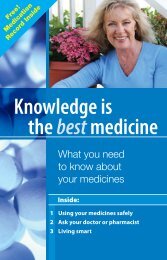Measles-Mumps-Rubella-Varicella (MMRV) Vaccine Program
Measles-Mumps-Rubella-Varicella (MMRV) Vaccine Program
Measles-Mumps-Rubella-Varicella (MMRV) Vaccine Program
Create successful ePaper yourself
Turn your PDF publications into a flip-book with our unique Google optimized e-Paper software.
(versus receiving the MMR and varicella vaccines<br />
separately).<br />
There is evidence to suggest that utilizing the<br />
<strong>MMRV</strong> vaccine has the potential to increase the<br />
uptake of the varicella vaccine and, thus, have a<br />
greater impact on controlling varicella disease.<br />
Two doses of the varicella vaccine are now<br />
recommended as part of the routine childhood<br />
schedule. Children will be offered this second dose<br />
of the varicella vaccine in the form of <strong>MMRV</strong><br />
vaccine.<br />
Q6: What is the epidemiology of measles, mumps,<br />
rubella and varicella in Ontario?<br />
A6: Before measles vaccine was used widely, almost<br />
all children got measles. Now, because of the<br />
routine use of vaccine, measles is rare in Canada.<br />
In fact, there were only 81 confirmed cases of<br />
measles reported in Ontario from 2006 to 2010.<br />
These cases were either imported or linked to<br />
imported cases.<br />
During the period 2006-2010, there were three<br />
mumps outbreaks in Ontario, the largest of which<br />
occurred in 2008 and resulted in 324 cases in a<br />
community with low immunization coverage.<br />
During this time there were 564 confirmed cases of<br />
mumps reported in Ontario.<br />
Since 2006, Ontario has reported an average of<br />
three cases (range two to five cases) of rubella per<br />
year with just 14 confirmed cases reported from<br />
2006 through to 2010. These cases were either<br />
imported or linked to imported cases.<br />
<strong>Varicella</strong> is mainly a childhood disease that<br />
develops in 50% of unvaccinated Canadian-born<br />
children before they reach five years of age and in<br />
90% of unvaccinated children before 12 years of<br />
age. Since the introduction of the one-dose<br />
varicella vaccine in 2004, Ontario reported 32,135<br />
cases of chickenpox. Eight hundred and fifty-six of<br />
these cases were severe, resulting in health<br />
complications, hospitalization or death. Since<br />
2008, approximately 7,400 cases of varicella have<br />
been reported annually in Ontario, a 23% reduction<br />
in annual reported cases.<br />
Q8. Why has the ministry moved the second dose of<br />
MMR vaccine from 18 months to the new<br />
<strong>MMRV</strong> vaccine at four to six years of age?<br />
A8. The ministry is continuing to recommend the first<br />
dose of the MMR vaccine at 12 months of age and<br />
the first dose of the varicella vaccine at 15 months<br />
of age as separate injections. For safety reasons,<br />
the ministry is not recommending the <strong>MMRV</strong><br />
vaccine as a first dose nor as a second dose at 18<br />
months of age.<br />
According to post-licensure studies in the United<br />
States on the <strong>MMRV</strong> vaccine, ProQuad , children<br />
who were 12 to 23 months of age were at a greater<br />
risk of febrile seizures when the ProQuad vaccine<br />
was given as the first dose compared with MMR<br />
and varicella vaccines given as a first dose<br />
separately at the same visit 1 .<br />
No data exists regarding the administration of the<br />
first dose of <strong>MMRV</strong> vaccine for children who are<br />
older. However, according to expert opinion, it is<br />
likely that children who are two to under four years<br />
old may experience febrile seizures because that is<br />
the biologic window of vulnerability for febrile<br />
seizures in children.<br />
There have been subsequent studies that compared<br />
the administration of the ProQuad vaccine as a<br />
second dose to children who were four to six years<br />
of age. These studies found that the rate of febrile<br />
seizures in children who received the <strong>MMRV</strong><br />
vaccine, as a second dose between four to six years<br />
of age, was similar to that found in children who<br />
received the second dose of the MMR and varicella<br />
vaccines separately at the same visit.<br />
Based on the available evidence from the<br />
ProQuad studies and in consideration of expert<br />
opinion, the ministry has chosen to offer the<br />
<strong>MMRV</strong> vaccine as a second dose to children who<br />
are at least four to six years of age. Furthermore, it<br />
is anticipated that this change from administration<br />
of the MMR vaccine at 18 months to the new<br />
<strong>MMRV</strong> vaccine at four to six years of age may<br />
help alleviate waning immunity to both mumps and<br />
varicella in later life.<br />
Q7: Who is eligible to receive the publicly funded<br />
<strong>MMRV</strong> vaccine and when should they receive it?<br />
A7: Refer to the eligibility criteria outlined in<br />
Attachment B - Table 1: ROUTINE MMR,<br />
<strong>Varicella</strong> and <strong>MMRV</strong> Immunization.<br />
1 Centers for Disease Control and Prevention. Use of combination<br />
measles, mumps, rubella and varicella vaccine: Recommendations of the<br />
Advisory Committee on Immunization Practices (ACIP). MMRW 2010;<br />
59:1-12.<br />
2


